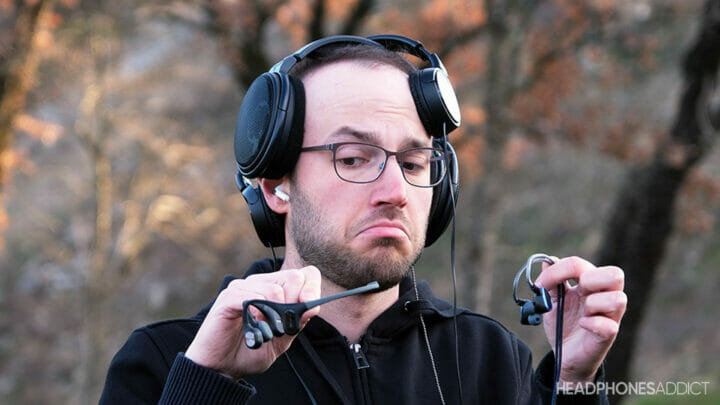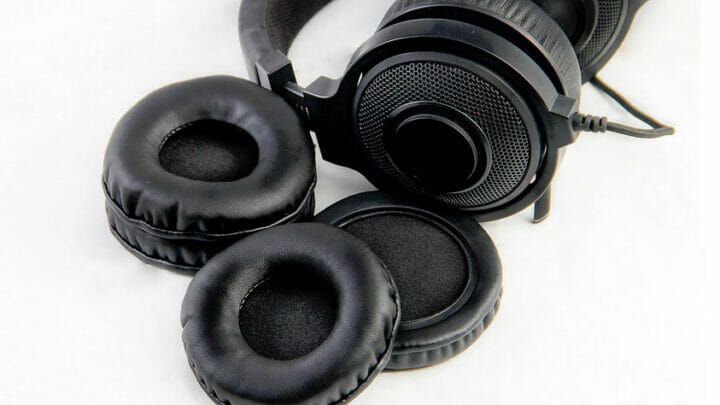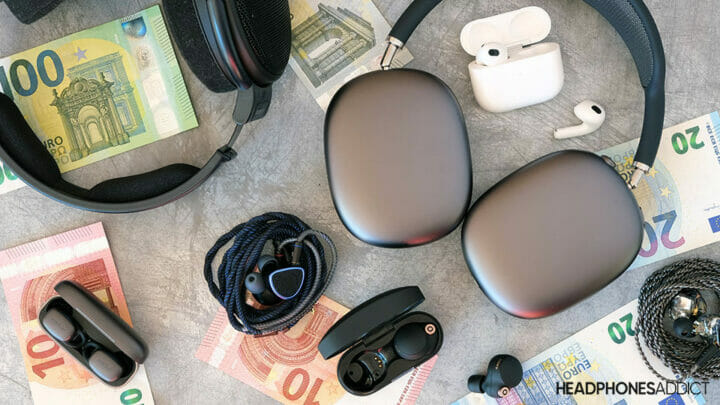Headphones can squeeze and scratch your ears, causing pain during long listening sessions.
In this article, you will learn:
- Why your ears start hurting based on the type of headphones you’re using
- What are the best solutions to reduce or prevent listener fatigue
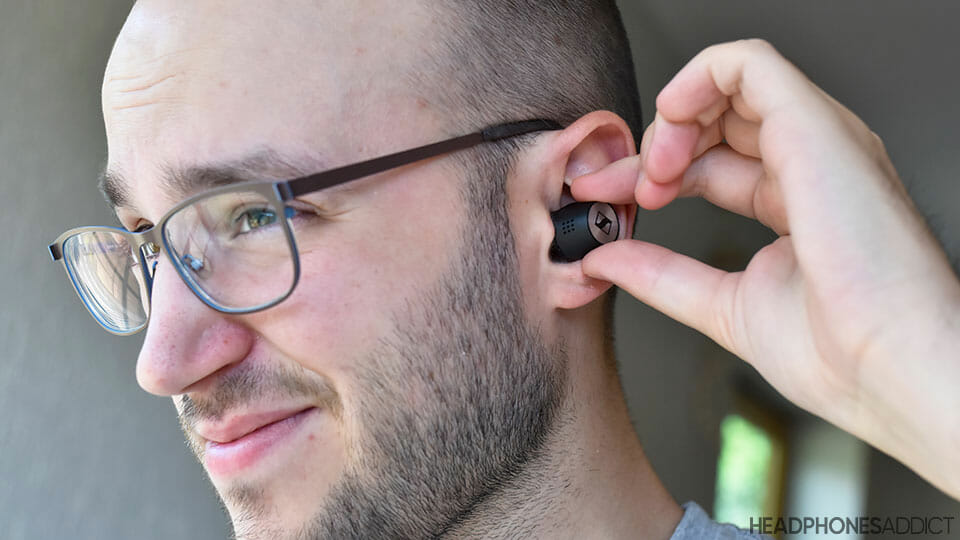
Causes of Ear Pain from Headphones and Earbuds
Why do my ears hurt when I put on headphones?
Well, ears can start aching due to many different factors. Some of which are:
- Excessive loudness: playing headphones too loud will aggressively vibrate your ear drums, which results in an unpleasant sensation.
- Improper fit: earpads that are too big and poke into your pinna, or earpads squishing cartilage inside your ears, result in pain.
- Prolonged use: while comfy at first, you start noticing the headphone’s pressure after some time, which eventually gets uncomfortable.
Headphones are designed to fit a regular human head. However, all people have slightly different heads and earlobe shapes, so the headphone’s comfort will vary from user to user.
In the majority of cases, pain originates from your ears. Depending on the type of headphones you’re using, the causes will be different.
Earbuds
Overly wide ear tips can cause pressure in your ear canal as if they’re trying to expand it. While okay at first, you start noticing the pressure after a while.

Some foam ear tips have a rough surface, scratch your ear canal and make it itchy. More on that later.
Earbuds, especially wireless ones, can be bulky. Unlike over-ear headphones, the hard plastic touches your ears when wearing them.
Big housings can touch your pinna. For example, JBL Reflect Mini NC feel fine when you start using them, but after 30 minutes, you notice they put a lot of pressure on your ear, forcing you to take a break.
Headphones
The primary source of why full-sized headphones hurt is earpads.
Small earpads aren’t big enough to accommodate the entire ear. Consequently, they squish a part of your earlobe. Eventually, the cartilage in your ear starts hurting.
Shallow earpads are responsible for your ears to touch the foam covering the drivers. That foam is usually thin, so you’re basically pressing against hard plastic.
Here’s a guide on how to replace them.
A stiff headband can also cause an ache on top of your head.
Below, we will discuss how to reduce ear pain from headphones and earbuds and how to prevent it.
Prevent Earbuds from Hurting Your Ears
As mentioned above, earbuds can cause pain due to various reasons. Most of them are preventable, but some aren’t. Here is what you can do.
Using the correct ear tips that fit your ears
Using ear tips that are too big not only worsens the seal (and sound quality) but also tries to widen your ear canal.
- If you experience that kind of discomfort, try smaller ear tips. Fitting tips will seal off your ear canal without causing any pressure.
Just don’t go too small, as earbuds will fall out of your ears.
Avoid ear tips that go too deep
Double or triple-flange ear tips provide excellent passive isolation but can be intrusive.
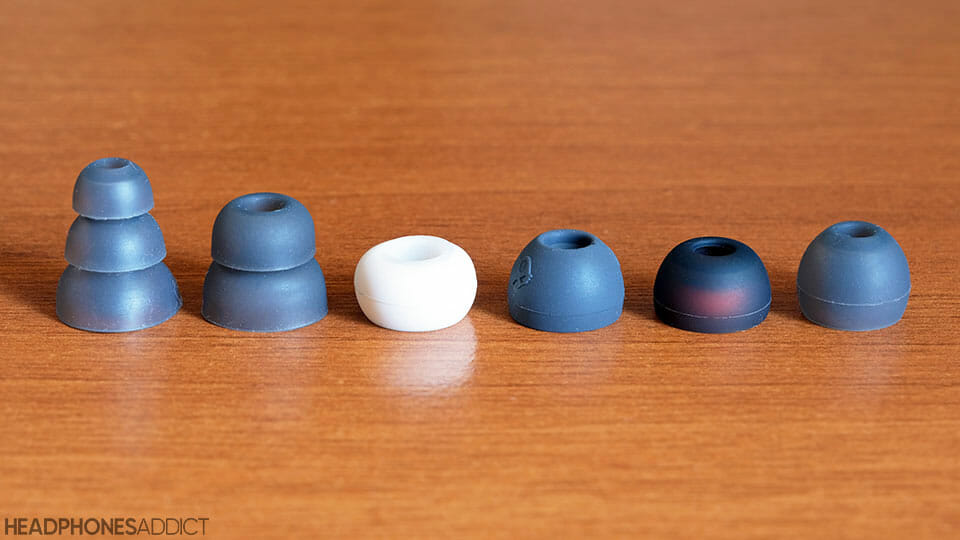
Firstly, they cause an annoying suction inside your ear canal. By moving the tip, you also move the eardrums, which doesn’t feel pleasant.
This kind of suction seal is dangerous if you accidentally tug on your earbuds and quickly pull them out of your ears. It might not damage your eardrums, but it is painful.
Wear earbuds the right way
To hold themselves in place, you have to twist the true wireless earbuds once they’re in ears.
Since earbuds can be bulky, it’s vital to know how to wear them properly. In many cases, you will find the instructions in the manual. Here’s our in-depth guide on how to wear different types of earbuds and headphones.
Take the earbuds out of your ears frequently
If the problem is in the bulky housing pushing against your pinna, you should probably replace your earbuds. But if you really love how they sound and don’t want to change them:
- Take a break every time they start hurting.
- Try twisting them a little, so they don’t always pressure on the same part of your ear.
Clean your earbuds and don’t share them to avoid germs
Your ear canals naturally lubricate with earwax. Add some body warmth, sweat, and dirt from the environment and you have a perfect climate for bacterial growth.

Poor hygiene, especially if your friends are borrowing your earbuds, can cause an infection that provokes inflammation.
- As long as you keep your earbuds clean (and your ears), you shouldn’t worry too much about getting an infection.
Keep the volume lower than max
If the inside of your ear hurts after listening, accompanied by a constant ringing, you should lower the volume.
- Listen to music someplace quiet where you don’t have to raise the loudness, or use active noise cancellation to reduce outside noise.
- Stay within 60% volume, so it is still a safe zone where you can listen to your headphones all day without worries (of course, not all headphones are equally loud).
Earbuds make my ears itchy
Earbuds users have probably encountered some itchiness already. Sometimes all you need is a little scratch, but sometimes, the itchiness can be more persistent. Here are some of the reasons.
Scratchy ear tips
Some foam tips that don’t use a coating to make the surface smoother can scratch your ear canal. Those scratches can start itching over time.
Comply is one of those brands that make foam ear tips with a rough surface, giving foam tips a bad reputation for being uncomfortable.
- If you like using foam tips, try a brand that has a smooth surface, like INAIRS.

Dirty ear canal
If you forgot to clean your ears for a while or weren’t thorough enough when cleaning, the earwax build-up can start itching.
- Clean your ears after a shower since the water and steam will soften the wax.
Earbuds give me earache
You probably have an ear infection if your ear canal is aching and the pain worsens when using earbuds.
- To deal with an ear infection, keep your ears clean and avoid using earbuds for a few days. If the issue doesn’t go away, visit your doctor.
- Allergic reaction is another way you can get a rash inside your ears. Contact dermatitis occurs a few days after contact with a problematic substance, like plastic or silicone.
Note that silicone allergy is extremely rare.
Remember that price doesn’t affect earbuds’ comfort nearly as much as in full-sized headphones.
Prevent Headphones from Hurting Your Ears
Headphones often come with different earpad sizes, padding materials, and weights.
If you’re buying new ones, take all of that into consideration. On the other hand, here is what you can do with your current headphones.
See if you can adjust the headband
If you feel like the headband is pressing too hard on your head or earpads squeeze the bottom of your earlobes, try to adjust the headband.
- Extend the headband adjustment to around half and put headphones on your head.
- With a hand on each side, hold the ear cup with 2 fingers while using the remaining fingers to push the headband down.
- Ensure the headband gently rests on your head and that earcups align perfectly with your ears.
- Also, make sure to align the headband in the middle.
If the headband is causing a headphone dent, read this.
Change the headphone earpads
Changing earpads is advisable if:
- They don’t fully cover your ears
- They’re too shallow and cause your ears to touch the driver inside
- They flatten down over time and become uncomfortable, possibly dirty, and full of cracks in the leather

If your existing earpads worsen with age, it’s best to buy original replacement ones. Mainly because they provide the most optimal sound performance.
On the other hand, if you aren’t happy with stock earpads, you will have to find some third-party ones.
- Search internet forums to see what kind of replacement pads people recommend for your headphones.
- Browse through Amazon or eBay for earpads designed for your headphones and check the reviews.
Try different headphones
If you’re currently using on-ear headphones, consider switching to over-ears.
On-ears are notorious for hurting your ears as they sit directly on your earlobes. While most have a gentle clamping force to reduce the pain, you will start noticing it eventually.
Why does my ear cartilage hurt with headphones?
Ear cartilages hurt with headphones because they get squeezed.
A human outer ear (earlobe) is primarily made from cartilage, which holds your earlobes in shape. It’s pretty sensitive, and it quickly starts hurting.
Cartilage is still relatively rigid, even though you can squeeze it. But by doing so, rigid parts start to stretch and compress. Eventually, those stretches and compressions start aching.
Some headphones make it worse than others. If you have problems with aching cartilage, try some of these solutions.
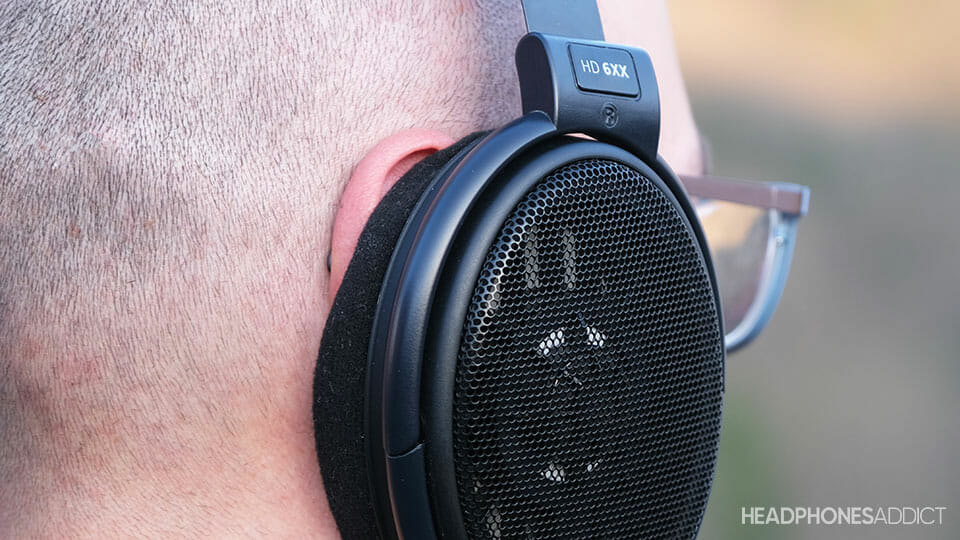
Get bigger headphones
Opt for bigger headphones if you currently use on-ears.
Get better earpads
Replace old earpads with newer ones, or switch to plushier third-party pads.
Make sure to get earpads that cover your entire ear. Pads that fit at least 3 knuckles should be wide enough.
My headphones hurt on top of my head
The headband is too stiff if headphones hurt the top of your head.
Some headphones have narrow or poorly padded headbands that don’t distribute the weight well. Here are a few solutions.
Adjust the headband
Extend the headband adjustments and readjust them so that you barely feel the headband on top of your head.

Add extra padding to your headband
If that doesn’t work, add extra padding around the headband. You can DIY using a piece of foam or buy a universal headband padding from Amazon.
Headphones make my inner ear painful
Headphones can make your inner ear painful due to various reasons. Thankfully, you can resolve most of them. Here are all the possible reasons.
Headphones are too loud
Similar to how eyes eventually get used to bright light, the same happens with your ears and sound. What was initially loud becomes normal.
While our perception seems normal, our middle and inner ears are put under stress when exposed to extreme loudness.
If you like cranking up the volume, this could be the reason for your aches.
Ear infection
While in-ear headphones block the ear canal and prevent it from cleaning itself, an ear infection can still occur in over-ear users.

It could be the result of poor ear hygiene.
Wearing headphones for countless hours also increases the heat and moisture in your ears, which is fantastic for bacteria.
If you suspect an infection (unpleasant sensation whenever you clean your ears, difficulties hearing, liquid coming out of them), keep them clean and take a break from headphones for a few days.
If the infection persists, visit a doctor.
Piercing treble
Headphones with an overly bright sound signature (boosted treble with very shimmery cymbals and pronounced sibilance when speaking letters “s”, “sh”, and “ch”) are known to cause listener fatigue.
Listener fatigue is also more common for closed-back headphones compared to open-back.
Sibilance can already be present in the original recording, but in most cases, it’s due to headphones’ tuning.
If that’s the case, try using an audio equalizer. You can check our complete guide on making your headphones sound better.
Wearing glasses with headphones hurt
When you wear glasses with headphones, the earpads squeeze the glasses’ frame and earlobes against your head. If you already feel pain without glasses, the pain will worsen when you put them on.
Use plusher earpads
The solution is to use plusher earpads with memory foam. The latter will equalize the pressure against your head, minimizing the pain.
Stretch the headphones
You can also stretch the headphones to reduce the clamping force.
- Place a box or a few books (has to be wider than your head) between earcups and let headphones sit for at least 24 hours.
- Try them out if the fit has loosened up. If not, repeat the process.
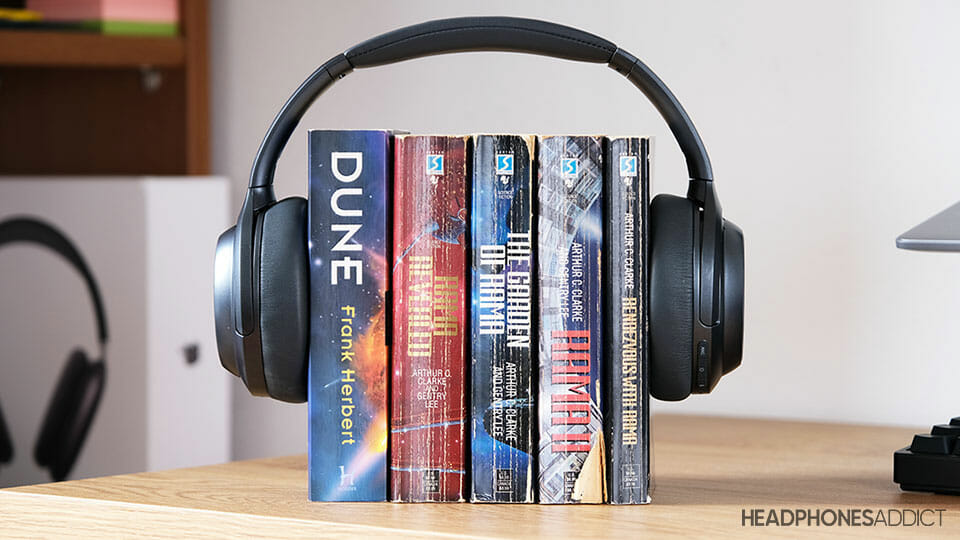
Risks of Ear Pain from Headphones
Ear pain after you wear headphones, primarily if it originates from the middle or inner ear, is nothing to joke about.
Some causes of pain are treatable, some might require medical attention, while others are irreversible. Let’s see what causes fall into these 3 categories.
Treatable
- Ear infection: keep your ears clean and take a more extended break from headphones/earbuds if infection occurs
- Itchy ears: make sure to regularly clean your ears to prevent earwax build-up
- Ear rash: you probably have an allergic reaction to something on your headphones; get yourself tested to find out what it is exactly
Requires medical attention
- Ear infections that don’t go away: if the infection persists for a couple of days, visit a doctor or ask a pharmacist for advice
- Constant pain in your middle and inner ears: you might have an inflammation that needs to be treated (to avoid unnecessary damage to the inner ears, which could lead to permanent hearing loss)
Irreversible damage
- Hearing loss: human hearing is very sensitive, and once damaged, you can’t heal or repair it, so avoid listening to loud music
- Tinnitus: a constant ringing in your ears at a specific frequency is a result of hearing damage (your brain will try to mask the ringing, but exposure to frequencies similar to the one you’re hearing will make your tinnitus temporarily worse)
Most importantly, all of these causes are preventable, so always practice good ear hygiene and safe headphone use.

Can headphones deform your ears?
No, headphones can’t deform your ears mainly because your ears get fully developed by the age of 7 to 8, with some minor changes up to the age of 13.
While it can sometimes look like your ears are more recessed after using headphones, don’t worry; they will return to their natural shape quickly.
Frequently Asked Questions (FAQ)
How do I stop headphones from hurting my ears?
You can stop headphones from hurting your ears by wearing them correctly, using plusher earpads that accommodate your entire earlobes, and loosening the clamping force if necessary. Also, practice good ear hygiene and avoid listening to overly high volumes.
Will my ears get used to headphones and earbuds?
Your ears will get used to headphones and earbuds if they only cause a tiny bit of pressure. Move them around in search of the comfiest position. However, if you already feel pressure on the first try, it will evolve into unbearable pain after half an hour or so.
Why do my headphones make my ears hurt?
Headphones make your ears hurt by compressing the cartilage, which is relatively solid. By squeezing it, you compress and stretch it, which eventually results in pain. Opt for bigger headphones that don’t press against your cartilage.
Do all headphones hurt your ears?
No, not all headphones hurt your ears. Some of them have big and plushy earpads to accommodate the entire ear without squeezing the cartilage. Likewise, some earbuds have an ergonomic shape that doesn’t poke your pinna.
How can I make my earbuds more comfortable?
You can make your earbuds more comfortable by trying different ear tips or by simply avoiding pushing them all the way down the ear canal. But firstly, ensure you’re wearing earbuds properly (most true wireless earbuds come with wearing instructions in the manual).
Why do my ears hurt when I listen to AirPods?
Like any other earbuds, AirPods can start hurting your ears if you wear them for too long and push them too deep into your ears. Constantly twisting and readjusting your AirPods will bruise your ear canal, while earwax build-up might cause an infection. Limit your time listening to AirPods and keep your ears clean to avoid future painful listening experiences.
Conclusion
Hopefully, now you better understand why earbuds and headphones hurt your ears and how to prevent that from happening. To recap the best solutions to avoid ear pain:
- Pick over-the-ear headphones with plush earpads that cover your entire ears
- Adjust your headphones properly (extend the headband, loosen up the clamping force) to avoid getting sore contact points
- Wear your earbuds properly and try different ear tips to see which fit better
- Avoid listening to music at very high volumes for extended periods
To ensure a comfortable listening experience right out of the box, choose one of the most comfortable headphones or earbuds if you don’t mind the in-ear fit.

From a childhood fascination with sound, Peter’s passion has evolved into a relentless pursuit of the finest headphones. He’s an audio expert with over 5 years of experience in testing both audiophile and consumer-grade headphones. Quote: “After many years, I can confidently tell which headphones are good and which are terrible.” Find his honest opinion in his reviews.

